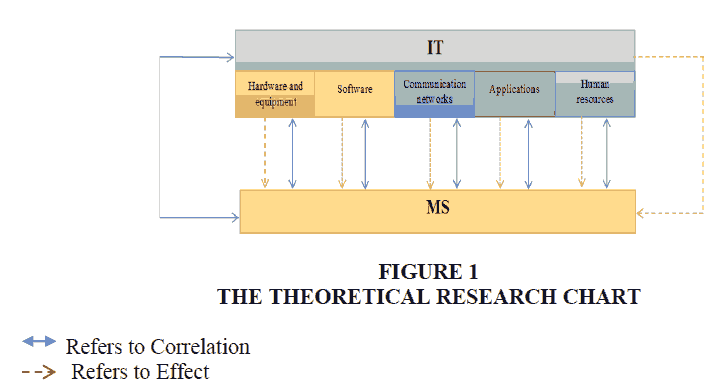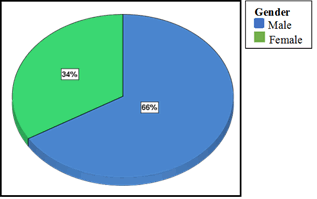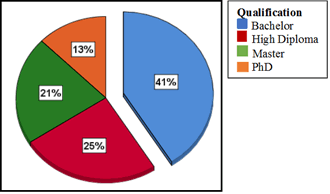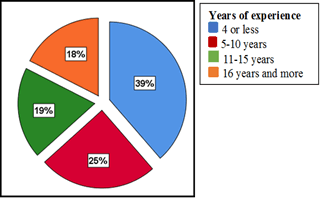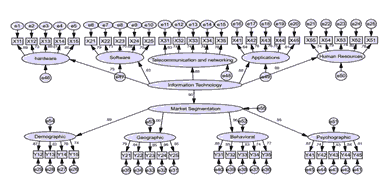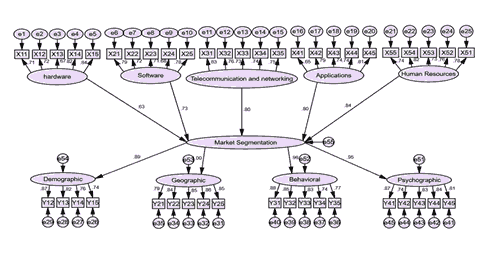Research Article: 2021 Vol: 20 Issue: 6S
The Impact of Information Technology on Promoting the Concept of Market Segmentation: An Analytical Study of the Views of Hotel Managers in the Kurdistan Region
Mustafa Obay Al-Dewachi, University of Mosul
Alaa Abdul Salam Al-Hamdani, University of Mosul
Abstract
The current study aimed at highlighting the extent to which information technology (henceforth, IT) contributes to the promotion of the concept of market segmentation (henceforth, MS) on a sample of hotel managers in the Kurdistan region. In this study, IT was used as an independent variable, while MS as a dependent variable. Based on this point, the problem of the study was identified by the following question: Does IT affect the promotion of MS in the hotels in question? To answer this question, hypotheses were developed and a questionnaire was designed to measure that purpose. As for the study community, it consisted of 500 participants, with a purposeful sample that included 217 participants of the directors of senior, middle and supervisory management in four- and five-star hotels in the Kurdistan region. Hence, 12 forms of questionnaire were excluded as being useless for analysis. Thus, the number of responses was 205 forms. In addition, statistical methods were employed to analyze the data including SPSS and AMOS. The study found a set of results, the most important of which is the presence of a direct and significant effect of IT on MS. Moreover, the study showed the presence of a direct and significant effect for each dimension of IT (hardware and equipment, software, communication networks, applications, and human resources) on MS. The study also provided recommendations including increasing the interest of hotels in IT through its components of hardware, equipment, software, applications, communication networks and human resources in all hotel operations that take place in hotels in order to facilitate access to the customer, and to bring the distance between the hotel and the customer. Additionally, the study recommended the necessity for paying attention to the process of MS through geographical, demographic, behavioral and psychological considerations to make it easier for hotels to divide customers and know their needs and requirements.
Keywords
IT, MS, Hotels in the Kurdistan Region
Introduction
Information and Communication Technologies (ICT) have changed the field of global tourism by the emergence of a wide range of tools and services that changed the way tourism companies operate as well as the way customers search for information and experience with tourist destinations. One of these technology tools is the Internet, which is a valuable tool for the consumer and processor. The use of Internet has increased in the field of communication, e-purchasing and dissemination of information. This is clear from the increase in the rate of electronic transactions through the Internet and the number of users. MS is a basic marketing concept whereby the market is segmented into subgroups of customers who behave the same behavior or have the same needs. The idea behind MS is to diagnose the group of customers similar in some considerations, such as their behavior while traveling or their motivations to travel. The development of this concept has contributed to the significant progress in IT that helps organizations of all kinds to reach the active MS that enables the organization to achieve its competitive advantage. The current research included five sections. The first section presents the methodology of the study, while the second deals with the theoretical framework. As for the third section, it shows the field framework and the fourth section discusses the results. Finally, the fifth section provides conclusions and recommendations.
Research Methodology
Research Problem
Based on researchers' survey and field visits to hotels in the Kurdistan region as well as reviewing the literature on the study title, dimensions and variables, there is an increase in the number of tourism organizations (hotels). However, these hotels did not pay sufficient attention to the special basics, standards and considerations in the field of active MS of customers. Accordingly, this requires employing technology developments in the field of hotel work. This, in turn, requires those organizations to focus on IT in order to promote the concept of MS. Thus, research problem is reflected in the following questions:
1. How much does IT contribute to promoting the concept of MS?
2. What is the nature of the relationships between IT and the promotion of the concept of MS?
Research Objectives
The current research seeks to achieve the following objectives:
1. Identifying the way of coordination and effective work between IT used in hotels on the one hand and the different MSs on the other, which reflects positively on customer satisfaction.
2. Developing a diagnostic framework for IT dimensions in the researched organization and their contribution to promoting the concept of MS.
3. Determining the extent to which each IT dimension is applied to MS.
The Theoretical Research Chart
Research Hypotheses
H1 There is no statistical significant correlation between IT dimensions and MS in the researched organization.
The sub-hypothesis derived from this main hypothesis is: There is no statistical significant correlation between each IT dimension individually and MS in the researched organization.
H2 There is no significant effect of IT dimensions on MS in the researched organization.
The sub-hypothesis derived from this main hypothesis is: There is no significant effect for each of IT dimensions individually on MS in the researched organization.
Research Scope
This research is limited to study the relationship between IT and MS in the four- and five- star hotels in the Kurdistan region including cities of Erbil, Dohuk and Sulaimaniyah, starting from 1/5/2021 to 20/7/2021.
Theoretical Background
Information Technology (IT)
a. The Concept of IT
Al-Azzawi & Yehya (2008) indicate that IT refers to the sources used by the organization in the operations and management of its data. These sources include equipment, software and various communications. While John (2015) states that IT refers to the various forms of technology that work and are used with information, whether information systems or the automation of industrial processes, and in computer communications between two organizations or even personal use in arithmetic operations. IT means inventions, products, methods and standards that aim to produce information and it consists of software, data, equipment, human resources and applications (Damianidou, 2018).
b. The Significance of IT
Organizations have recently become increasingly interested in the concept of IT and the significant role it plays in their success in terms of carrying out organization-related functions, such as regulation, planning, decision-making and control. Therefore, the importance of IT is summarized as follows (Syahchari, 2020):
1. It contributes to the organization's changes in business procedures, and hence work becomes shorter, time and space are reduced, providing continuity of knowledge availability and new form of business administration.
2. It provides new strategic opportunities for the organization, identifies the evaluation and redefinition of the organization vision, goals, strategies and processes.
3. It reduces a large number of jobs because they are not needed, as well as creating new job opportunities.
4. It helps organizations make good decisions and use effective communication systems.
c. IT Dimensions
IT is not effective without its dimensions. When reviewing the literature, Artur (2020); Bujang, Naho & Awang (2019); Laudon & Laudon (2020) agree that IT dimensions are:
Hardware and Equipment
Laudon & Laudon (2020) indicate that hardware and equipment are the responsible part used in input, output, storage, and follow-up and transmission process of data. They include active equipment and hardware in systems processes, such as computer and its accessories, copiers, display screens, control devices, routers and many other related devices. They (2020) consider the computer as the backbone that is required to operate other components, such as networks, applications and software. While Asongu & Odhiambo (2020) opine that the material components of all computer-related equipment approved in the process of input and processing of data to become valuable information are used in the decision-making process and they include computer and its accessories, such as router, printer, hard disks, etc.
Software
Laudon & Laudon (2020) demonstrate that software is the one that makes the computer and everything associated with it work, process and accomplish various applications. Software represents rules, models and instructions that help to do specific tasks and process data. Bannister & Grönlund (2017) argue that computers without software are metal and useless parts. Software refers to the visual instructions that make the computer capable of performing the tasks required from the user. Therefore, software is the one that gives effectiveness to IT.
Communication Networks
Ellul (2018) shows that communication networks transfer data from one location to another. The networks consist of software, hardware and equipment that connect various parts of the devices. Communication networks refers to the process of connecting more than one computer in one building or in one city or around the world to ensure the transfer of data in accordance with the controls and rules (Kuraesin & Suharman, 2021).
Applications
Muhammedrisaevna, Mubinovna & Kizi (2020) believe that the scientific aspect of IT is done through developing solutions by providing the application that include networks technology. It is not limited only to computer, but also involves data in the overall administrative processes, in addition to storage and processing of data. Ricci (2017) points out that applications refer to the executive aspect of software on hardware and equipment, whereby technology can reach its main objectives as they have a significant role in the application of different administrative processes.
Human Resources
Human resources are the most important link in the elements of ICT. They are responsible for the failure or success of the system (Tavani, 2013). Human resources are the business spirit of the organization whereby business organizations succeed and fail. When managed properly, they achieve the dream of each organization of growth, survival, continuity and vice versa. The same is applied to IT as the human element is primarily effective in its entire internal and external processes of storage, programming and processing (Schermerhorn, Golden, Krynitsky & Leimkuehler, 2005).
Market Segmentation (MS)
a. The Concept of MS
Kotler (2018) define MS as working to divide the market into homogeneous subdivisions of customers. It is chosen as an accessible target with a distinct marketing mix. It is a procedure dividing the market into inactive groups of customers. While Ernst and Dolnicar (2018) find that MS is the process of assembling or fragmenting customers. MS is a strategy that divides markets into homogeneous groups to give organizations the ability to target certain potential customers who represent the greatest opportunity for organizations to reach those (Chaubey & Subramanian, 2020).
b. The Significance of MS
The organization can gain many benefits by dividing the market if it is based on appropriate basics and criteria including (Kotler et al., 2018; Schneider & Jadczaková, 2016):
1. It contributes and helps to satisfy needs in the best way.
2. It provides the organization with useful information that contributes to product development, marketing research, evaluation of marketing activities and other beneficial aspects.
3. It directs funds and efforts to the most profitable aspects.
4. It achieves production of goods and services in accordance with the actual demands of consumers.
5. It contributes and helps to achieve effective marketing policy.
MS Dimensions
Through reviewing the literature, Dolnicar, Grün & Leisch (2018); Kotler et al., (2018); Liu & Liao (2019) agree that MS dimensions are:
a. Demographic Variables
These variables constitute the largest share among other variables that are given the utmost importance when dividing the market in terms of age, gender, family size, monthly income, nature of work and other basic variables associated with customers. All of these elements are measurable (Kotler et al., 2018).
b. Geographical Variables
Within this concept, the market is divided into geographical units, such as State, region, city, and other divisions known locally and globally. According to its potential, the organization can operate in one or more regions simultaneously, or operate on a comprehensive scale locally or internationally, while responding to the different demands of customers from one region to another. This is achieved whether in relation to changing the characteristics of the products provided or the products are receiving the correct answer in the various segmented markets (Damijani?, 2021).
c. Behavioral Variables
Although this set of behavioral variables gives a deep understanding to the customer or consumer, many organizations do not succeed or fail to deal with them. Organizations divide customers purchasing the item or service into groups according to considerations of attitudes, tendencies, uses, or response to the commodity or service (Kotler et al., 2018).
d. Psychological Variables
These factors include lifestyle, the personality of the customer and the social class. Lifestyle varies between members of the same society. There is the rate of expenditure that depicts lifestyle, the tendency to saving or spending, and aspects on which expenditure is increased or decreased. In addition to other factors that would represent lifestyle in the environment or one society (Alt & Iversen, 2017).
Field Work
Description of the Study Community and Reasons for Selection
The study community includes four- and five- star hotels in the three provinces of Kurdistan (Erbil, Dohuk, Sulaimaniyah). The number of five-star hotels in Kurdistan region is (27) hotels, and hence only (16) hotels representing (60%) are selected to be studied. While the number of four-star hotels is (56) hotels and only (22) hotels representing (40%) are selected to be studied. The most important reasons for selecting these organizations as a field of research are:
1. Tourism is a broad and sensitive sector. This sector becomes a global industry for additional income for all developed as well as developing countries, especially if technology is applied to it.
2. Hotels have an economic status and importance as they play an active role in increasing the economic growth of the Kurdistan region including labor employment and reducing unemployment.
3. The demand for tourism in Kurdistan region is increasing day after day as customers from all Iraqi provinces as well as from outside Iraq visit hotels in all seasons, events and holidays.
Description of Research Sample
According to the data provided by participants through their answers to the first part (general information) of the questionnaire, the research sample is characterized as follows:
a. Gender
Figure (2) shows that the majority of research participants are male by nature of work represented by (66%), which is higher than (34%) represented by females in the field researched, reflecting the high proportion of male workers in hotels.
b. Qualification
Figure (3) presents that the rate of participants with Bachelor degree and Diploma is (66%), representing the dominant group. Furthermore, the research field consists of higher degrees represented by (34%). Therefore, it is concluded that the research sample is well experienced, competent and able to understand the questions of the study and answer them accurately.
c. Years of Experience
Figure (4) demonstrates that the rate of participants with job experience (less than 4 years) is (39%), representing the largest rate among participants concerned, followed by (5-10 years) by (25%). While the lowest percentage (18%) is for (more than 16 years). This reflects the diversity of participants' skills in their field so that they can accomplish the tasks assigned to them efficiently and effectively.
Measuring the Correlation Between it and Ms in Organizations Concerned
Table (1) shows that there is a direct correlation between IT and MS by the value of correlation coefficient that is equal to (0.658). This correlation is significant based on the probability value (P-value) that is equal to (0.000) and is less than (0.05). Accordingly, the first main hypothesis is rejected and its alternative hypothesis, which provides for a significant correlation between IT and MS in organizations concerned, is accepted.
| Table 1 Values of Correlation Coefficients Between IT and MS |
||
|---|---|---|
| Correlations | ||
| MS | ||
| 0.658** | Pearson Correlation | IT |
| 0 | P-value | |
| 205 | N | |
Measuring the Correlation between Each IT Dimension and MS in Organizations Concerned
Table (2) presents a direct significant correlation between each IT dimension and MS by the value of correlation coefficient, that all of which are positive. These correlations are also significant based on the probability value (P-value), that all of which are equal to (0.000) and are less than (0.05). The sub-hypothesis of the first main hypothesis is therefore rejected and its alternative hypothesis, which provides for a significant correlation between each IT dimension and MS, is accepted.
| Table 2 Values of Correlation Coefficients Between Each It Dimension and MS |
||||||
|---|---|---|---|---|---|---|
| Correlations | ||||||
| Hardware | Software | Telecommunication and networking | Applications | Human resources | ||
| 0.614** | 0.587** | 0.544** | 0.270** | 0.680** | Pearson Correlation | MS |
| 0 | 0 | 0 | 0 | 0 | P-value | |
| 205 | 205 | 205 | 205 | 205 | N | |
Measuring the Effect of it on Ms in Organizations Concerned
Measuring the Effect of all IT Dimensions on MS in Organizations Concerned
Figure (5) indicates the significance of the model designed by the values of high saturations. The results of statistical analysis in table (3) show a direct and significant effect of IT on MS by the value of the regression factor of (1.169). This indicates that the more IT, the more segmented the market. This significant effect is shown by the probability value (P-value) (0.011), which is less than (0.05). The same result confirms the similarity of the upper and lower bounds of confidence interval (95%) of the model. Consequently, the second main hypothesis is rejected and its alternative, which provides for the effect of all IT dimensions on MS, is accepted.
| Table 3 Regression Analysis of The Effect of IT on MS |
|||||||
|---|---|---|---|---|---|---|---|
| Independent variable | Direct of the effect | Dependent variable | Estimate | SRW | (95%) Confidence interval | P-value | |
| IT | → | MS | 0.902 | 1.169 | Lower Bound | 0.691 | 0.011 |
| Upper Bound | 1.863 | ||||||
Measuring the Effect of Each IT Dimension on MS in Organizations Concerned
Figure (6) and Table (4) demonstrate the results of statistical analysis of each IT dimension on MS, as follows:
a. There is a direct and significant effect of hardware on MS by the value of the regression factor (0.943). This indicates that the more hardware and equipment, the more segmented the market. This effect is significant by (P-value) (0.005), which is less than (0.05). The same result confirms the similarity of the upper and lower bounds of confidence interval (95%) of the model.
b. There is a direct and significant effect of software on MS by the value of the regression factor (0.787). This indicates that the more software, the more segmented the market. This effect is significant by (P-value) (0.015), which is less than (0.05). The same result confirms the similarity of the upper and lower bounds of confidence interval (95%) of the model.
c. There is a direct and significant effect of communication networks on MS by the value of the regression factor (0.934). This indicates that the more communication networks, the more segmented the market. This effect is significant by (P-value) (0.012), which is less than (0.05). The same result confirms the similarity of the upper and lower bounds of confidence interval (95%) of the model.
d. There is a direct and significant effect of applications on MS by the value of the regression factor (1.091). This indicates that the more applications, the more segmented the market. This effect is significant by (P-value) (0.007), which is less than (0.05). The same result confirms the similarity of the upper and lower bounds of confidence interval (95%) of the model.
e. There is a direct and significant effect of human resources on MS by the value of the regression factor (1.097). This indicates that the more human resources, the more segmented the market. This effect is significant by (P-value) (0.019), which is less than (0.05). The same result confirms the similarity of the upper and lower bounds of confidence interval (95%) of the model.
Based on the above, the second sub-hypothesis is rejected and its alternative, which provides for a significant effect of each IT dimension on MS in organizations concerned, is accepted.
| Table 4 Analysis of the Effect of Each IT Dimension On MS |
|||||||
|---|---|---|---|---|---|---|---|
| Independent variable | Direct of the effect | Dependent variable | Estimate | SRW | (95%) Confidence interval | P-value | |
| Hardware | → | MS | 0.943 | 0.635 | Lower Bound | 0.63 | 0.005 |
| Upper Bound | 1.667 | ||||||
| Software | → | 0.787 | 0.727 | Lower Bound | 0.59 | 0.015 | |
| Upper Bound | 1.006 | ||||||
| Telecommunication and networking | → | 0.934 | 0.804 | Lower Bound | 0.722 | 0.012 | |
| Upper Bound | 1.146 | ||||||
| Applications | → | 1.091 | 0.803 | Lower Bound | 0.836 | 0.007 | |
| Upper Bound | 1.497 | ||||||
| Human resources | → | 1.097 | 0.837 | Lower Bound | 0.809 | 0.019 | |
| Upper Bound | 1.35 | ||||||
Discussion of Results
The results of the current study are consistent with results of Buhalis & Jun (2011) where they opine that the development of ICT has made significant progress in MS. For example, many electronic construction systems, such as cooperative filtering systems have emerged that contribute to accurate analysis of customer characteristics. The companies can therefore collect and analyze a lot of information and data electronically. This indicates an increase in the potentials provided by ICT in segmenting the tourism market and changing this segmentation method and the great role that IT plays.
The current results also agree with those found by Pesonen (2013) that the benefits of IT and its contribution to MS are significant, as the most aspects of MS affected by Internet technology and ICT are data collection. Most studies on MS use direct electronic questionnaires or e-mail in data collection and use websites to analyze sources of information and divide customers according to this information or by the rate of expenditure. Moreover, Global Positioning Systems (GPS) are used to collect temporal and spatial data about visitors to tourist sites to divide tourists on the basis of such data.
Conclusion
The study concludes the following results:
1. There is a direct and significant correlation between IT variable and MS variable in researched organizations concerned.
2. There is a direct and significant correlation between each IT dimension with MS by the value of the correlation factors, as all of them are positive. This indicates that IT contributes significantly to the promotion of the effective MS of the hotels researched.
3. At the overall level of research organizations, IT positively affects the promotion of MS.
4. There is a direct and significant effect for each IT dimension (hardware and equipment, software, communication networks, applications, and human resources) on MS variable. This shows that the more technology is used in the hotels researched, the more the process of effective MS of customers, reflecting positively on the researched organization.
Recommendations
The study suggests the followings recommendations:
1. Hotels have to increase the interest in IT through their components of hardware, equipment, software, applications, communication networks and human resources in all hotel operations that take place within hotels in order to facilitate access to the customer, bring the distance between the hotel and the customer, and to achieve competitive advantage, excellence and expansion of competitors.
2. Hotels should create IT sections for following up and keeping up with all the new rapid progress in IT and keeping up with all that is modern and constantly applied, reflecting positively on the hotel and customer.
3. Hotel management should pay attention to the process of MS through geographical, demographic, behavioral and psychological considerations, which makes it easier for hotels to segment customers and know their needs and requirements.
4. The process of MS of customers should be based on IT, as the development in ICT has made significant progress in MS that hotels can collect and analyze a lot of information and data about customers electronically. This means that there is an increase in the potentials provided by IT in segmenting the tourism market and changing the way it is segmented.
References
- Al-Azzawi, M., & Yehya, A. (2008). The effect modern information and communication technology in effectiveness of marketing performance. The Journal of Tanmiyat Al-Rafidain, 30(91), 239-258.
- Alt, J., & Iversen, T. (2017). Inequality, labor market segmentation and preferences for redistribution. American Journal of Political Science, 61(1), 21-36.
- Artur, V. (2020). Information technology. Retrieved from https://www.researchgate.net /publication.339237952.
- Asongu, S.A., & Odhiambo, N.M. (2020). Foreign direct investment, information technology and economic growth dynamics in Sub-Saharan Africa. Telecommunications Policy, 44(1), 101838.
- Bannister, F., & Grönlund, Å. (2017, January). Information technology and government research: A brief history. In Proceedings of the 50th Hawaii International Conference on System Sciences.
- Buhalis, D., & Jun, S. (2011). "E-Tourism": Contemporary tourism reviews. Oxford: Goodfellow Publishers Limited.
- Bujang, A., Naho, A., & Awang, N. (2019). The application of Information and Communication Technology (ICT) in teaching and learning. ILKKM Journal of Medical and Health Sciences, 1(2), 1-5.
- Chaubey, D., & Subramanian, K. (2020). The complexity of market segmentation process. International Journal of Engineering Research and Management (IJERM), 7(5).
- Damianidou, D., Foggett, J., Arthur-Kelly, M., Lyons, G., & Wehmeyer, M.L. (2018). Effectiveness of technology types in employment-related outcomes for people with intellectual and developmental disabilities: An extension meta-analysis. Advances in Neurodevelopmental Disorders, 2(3), 262-272.
- Damijani?, A.T. (2021). Travel motivations as criteria in the wellness tourism market segmentation process. Academica Turistica-Tourism and Innovation Journal, 13(2).
- Dolnicar, S., Grün, B., & Leisch, F. (2018). Market segmentation analysis: Understanding it, doing it, and making it useful. Singapore: Springer.
- Ellul, J. (2018). The technological system. Eugene, US: Wipf and Stock Publishers.
- Ernst, D., & Dolnicar, S. (2018). How to avoid random market segmentation solutions. Journal of Travel Research, 57(1), 69-82.
- John, S.P. (2015). The integration of information technology in higher education: A study of faculty's attitude towards IT adoption in the teaching process. Contaduría y Administración, 60, 230-252.
- Kotler, P., Keller, K.L., Ang, S.H., Tan, C.T., & Leong, S.M. (2018). Marketing management: An Asian perspective. Singapore: Pearson.
- Kuraesin, A.D., & Suharman, H. (2021). The influence of information technology on the quality of accounting information systems survey in Bandung City University. Psychology and Education Journal, 58(1), 2642-2648.
- Laudon, K.C., & Laudon, J.P. (2020). Management information systems: Managing the digital firm. New York NY: Pearson.
- Liu, J., Liao, X., Huang, W., & Liao, X. (2019). Market segmentation: A multiple criteria approach combining preference analysis and segmentation decision. Omega, 83, 1-13.
- Muhammedrisaevna, T.M., Mubinovna, R.F., & Kizi, M.N.U. (2020). The role of information technology in organization and management in tourism. Academy, 4(55).
- Pesonen, J.A. (2013). Information and communications technology and market segmentation in tourism: A review. Tourism Review, 68(2), 14-30.
- Ricci, C. (2017). Application and open source information technology policy filter.
- Schermerhorn, P.G., Golden, P.E., Krynitsky, A.J., & Leimkuehler, W.M. (2005). Determination of 22 triazole compounds including parent fungicides and metabolites in apples, peaches, flour, and water by liquid chromatography/tandemmass spectrometry. Journal of AOAC International, 88(5), 1491-1502.
- Schneider, J., & Jadczaková, V. (2016). Mutual impacts of geocaching and natural environment. Acta Universitatis Agriculturae et Silviculturae Mendelianae Brunensis, 64(5), 1739-1748.
- Syahchari, D.H., Saroso, H., Sudrajat, D., & Herlina, M.G. (2020, August). The effect of information technology, strategic leadership and knowledge management on the competitive advantage in the chemical industry. In 2020 International Conference on Information Management and Technology (ICIMTech).
- Tavani, H.T. (2013). Ethics and technology. New Jersey, US: Wiley.
